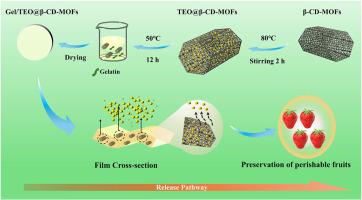Gelatin-based film applying cyclodextrin metal-organic frameworks for controlled release of thyme essential oil: Development, characterization and application in fruit preservation
IF 11
1区 农林科学
Q1 CHEMISTRY, APPLIED
引用次数: 0
Abstract
In this study, thyme essential oil (TEO) was encapsulated into β-cyclodextrin metal-organic frameworks (β-CD-MOFs), and the resulting TEO@β-CD-MOFs complex was incorporated into a gel matrix to prepare the Gel/TEO@β-CD-MOFs nanocomposite films. Compared with previous studies that encapsulated macromolecular antibacterial substances into β-CD, the encapsulation of TEO into β-CD-MOFs achieved a higher encapsulation efficiency (88.26 %) and demonstrated superior antibacterial (antibacterial rate >95 %) and antioxidant (free radical scavenging rate >75 %) properties. This approach also facilitated a slower and more controlled release of TEO during storage. The shelf life of strawberries was extended to 8 days, further confirming the enhanced preservation performance of the Gel/TEO@β-CD-MOFs nanocomposite film. Moreover, the addition of 7.5 % TEO@β-CD-MOFs into the gel matrix, improved the mechanical properties of the film, with the tensile strength (TS) reaching 15.73MPa and the elongation at break (EB) increasing to 14.69 %. The water contact angle (WCA) remained at a favorable hydrophobic level of 95.84°. In conclusion, the nanocomposite films developed in this study exhibit promising potential for application in fruit preservation.

应用环糊精金属有机骨架的明胶基百里香精油控释膜:开发、表征及其在水果保鲜中的应用
本研究将百里香精油(TEO)包封在β-环糊精金属有机骨架(β-CD-MOFs)中,并将所得的TEO@β-CD-MOFs配合物掺入凝胶基质中,制备凝胶/TEO@β-CD-MOFs纳米复合膜。与以往将大分子抗菌物质包封在β-CD中的研究相比,TEO包封在β-CD- mofs中获得了更高的包封效率(88.26%),并表现出较好的抗菌(抑菌率>; 95%)和抗氧化(自由基清除率>; 75%)性能。这种方法还有助于在存储过程中更慢、更可控地释放TEO。将草莓的保质期延长至8天,进一步证实了凝胶/ teo @β- cd - mof纳米复合膜的保存性能增强。此外,在凝胶基体中加入7.5%的TEO@β-CD-MOFs,薄膜的力学性能得到改善,拉伸强度(TS)达到15.73MPa,断裂伸长率(EB)提高到14.69%。水接触角(WCA)保持在95.84°的有利疏水水平。综上所述,本研究制备的纳米复合薄膜在水果保鲜方面具有广阔的应用前景。
本文章由计算机程序翻译,如有差异,请以英文原文为准。
求助全文
约1分钟内获得全文
求助全文
来源期刊

Food Hydrocolloids
工程技术-食品科技
CiteScore
19.90
自引率
14.00%
发文量
871
审稿时长
37 days
期刊介绍:
Food Hydrocolloids publishes original and innovative research focused on the characterization, functional properties, and applications of hydrocolloid materials used in food products. These hydrocolloids, defined as polysaccharides and proteins of commercial importance, are added to control aspects such as texture, stability, rheology, and sensory properties. The research's primary emphasis should be on the hydrocolloids themselves, with thorough descriptions of their source, nature, and physicochemical characteristics. Manuscripts are expected to clearly outline specific aims and objectives, include a fundamental discussion of research findings at the molecular level, and address the significance of the results. Studies on hydrocolloids in complex formulations should concentrate on their overall properties and mechanisms of action, while simple formulation development studies may not be considered for publication.
The main areas of interest are:
-Chemical and physicochemical characterisation
Thermal properties including glass transitions and conformational changes-
Rheological properties including viscosity, viscoelastic properties and gelation behaviour-
The influence on organoleptic properties-
Interfacial properties including stabilisation of dispersions, emulsions and foams-
Film forming properties with application to edible films and active packaging-
Encapsulation and controlled release of active compounds-
The influence on health including their role as dietary fibre-
Manipulation of hydrocolloid structure and functionality through chemical, biochemical and physical processes-
New hydrocolloids and hydrocolloid sources of commercial potential.
The Journal also publishes Review articles that provide an overview of the latest developments in topics of specific interest to researchers in this field of activity.
 求助内容:
求助内容: 应助结果提醒方式:
应助结果提醒方式:


